
Key Findings
- Interest in data science has risen 610% since 2012.
- San Francisco, San Jose, and Seattle are the best metropolitan areas for data science careers.
- 21.1% of computer science, computing, and mathematics students are committed to pursuing a career in data science, while 52.2% are considering it.
Data scientist and analyst careers have exploded along with the increase in companies using big data. Fortunately for those interested in the field, this huge demand comes with some hefty salaries. So exactly who in the U.S. is benefitting from the ability to clean, manipulate, and interpret data? Which areas of the country are becoming the biggest hot spots for these desired roles, and how can companies who perhaps can’t afford these large salaries still benefit from the new frontier of data?
As data scientists ourselves, we were able to use data to answer each of these burning questions and more. By interpreting thousands of data points from the U.S. Bureau of Labor Statistics (BLS), Google Trends, and a survey of hundreds of future data professionals, the current state and future of data careers is now better understood. If you’re interested in this growing profession—or utilizing it for your benefit—keep reading.
Data Science on the Rise
A career in data science specifically refers to the invention of and discovery and utilization of new methods for extracting and interpreting data. The study kicks off with a look into how much this particular field has been garnering interest and where, according to Google Trends data.
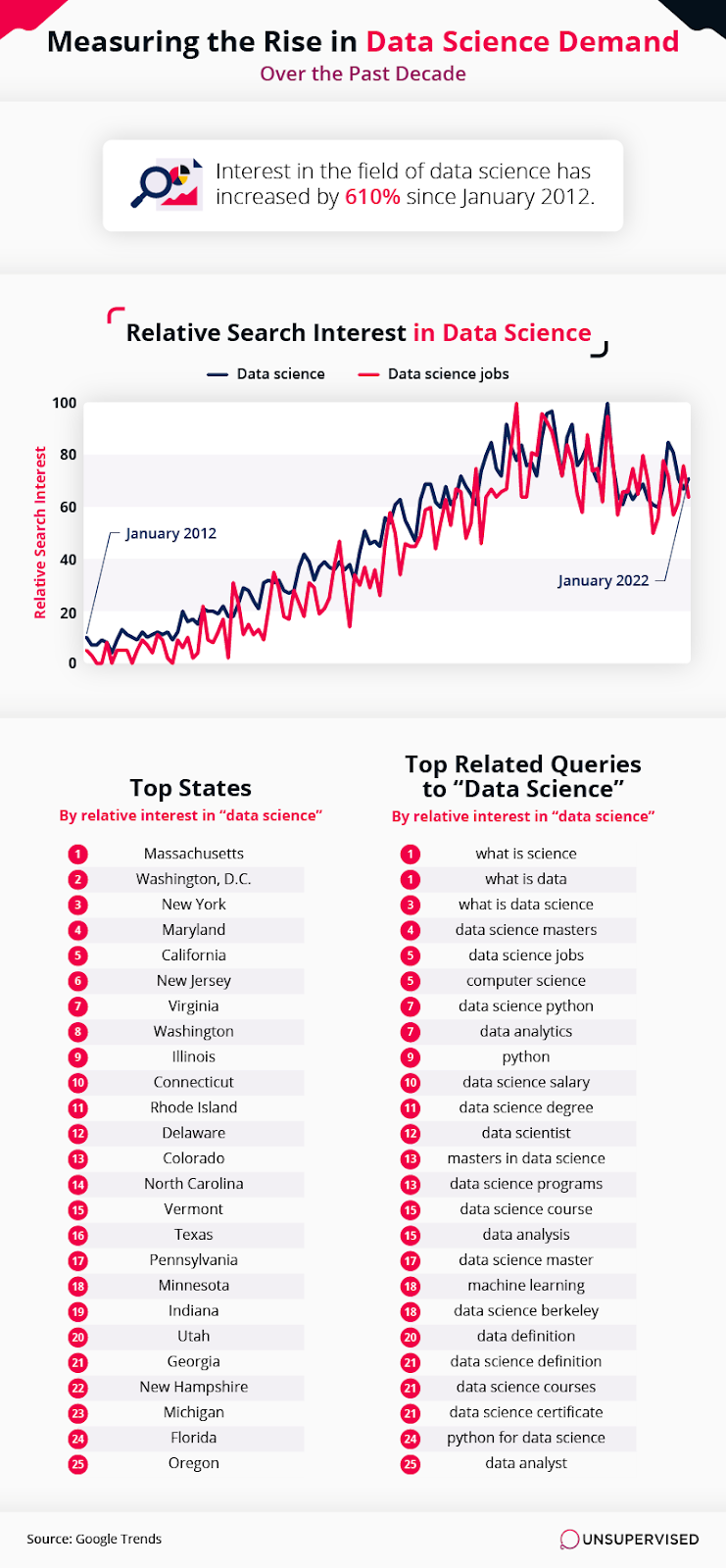
The overall impression from the interest graph is clear: Interest in “data science” and “data science jobs” is (and has been) on the rise. In fact, interest in the field of data science has increased by a staggering 610% in the past decade. Specifically, a majority of people were wondering about relatively simple things, like “What is data science?” and “What is data?”
But not all types of interest were distributed equally. People from Massachusetts searched data science-related topics more than any other state in the country. This state is particularly known for its impressive, tech-related schools, like Harvard and MIT, and is considered the single-most educated state in America. And for those who weren’t searching about data basics, “data science masters” was the next most popular search—something Massachusetts schools offer plenty of.
Data Industry Disbursement in the U.S.
Data-related searches and education may have been concentrated in Massachusetts, but where was the actual data science profession flowing? This piece of the study highlights the total data science employment by state in 2020 according to the BLS.
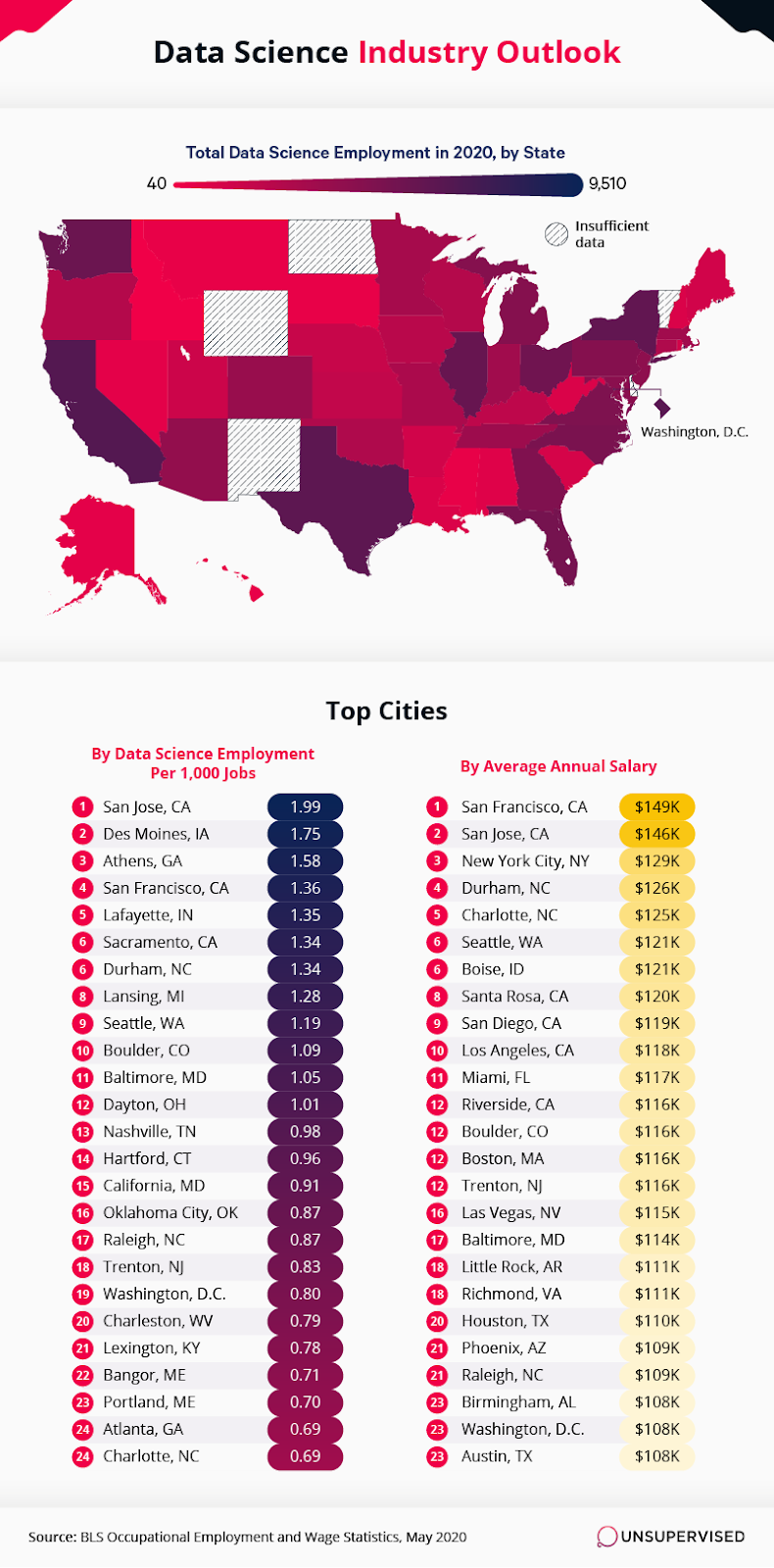
Californian cities came out on top in many ways with regards to data professionals. Home to Silicon Valley and many of the major tech giants, these areas are clearly able to draw in the data professionals. San Jose had more data science employment per 1,000 people than any other city in the U.S., while San Francisco came in fourth, and Sacramento landed in sixth. Other notable mentions were Des Moines, Iowa, and Athens, Georgia, which came in 2nd and 3rd, respectively.
Where salary was concerned, California technically paid the most, but their cost of living may diminish this appeal. While San Francisco paid its data professionals $149,000 annually, on average—more than any other city—this same location is one of the most expensive cities in the entire country, second only to New York City, which by comparison, paid its data professionals only an average of $129,000. Even San Jose, which has a significantly lower cost of living, paid its data professionals more, on average, than New York City. This may indicate why California is having an easier time recruiting for this career.
Where Data Scientists Thrive
In order to determine the “best” cities for data scientists, we factored in the total employment of the area, the job opportunities, and the average annual salary, all based on data from BLS’ Occupational and Wage Statistics for May of 2020. Then we compared the fastest-growing cities for data employment and wage.
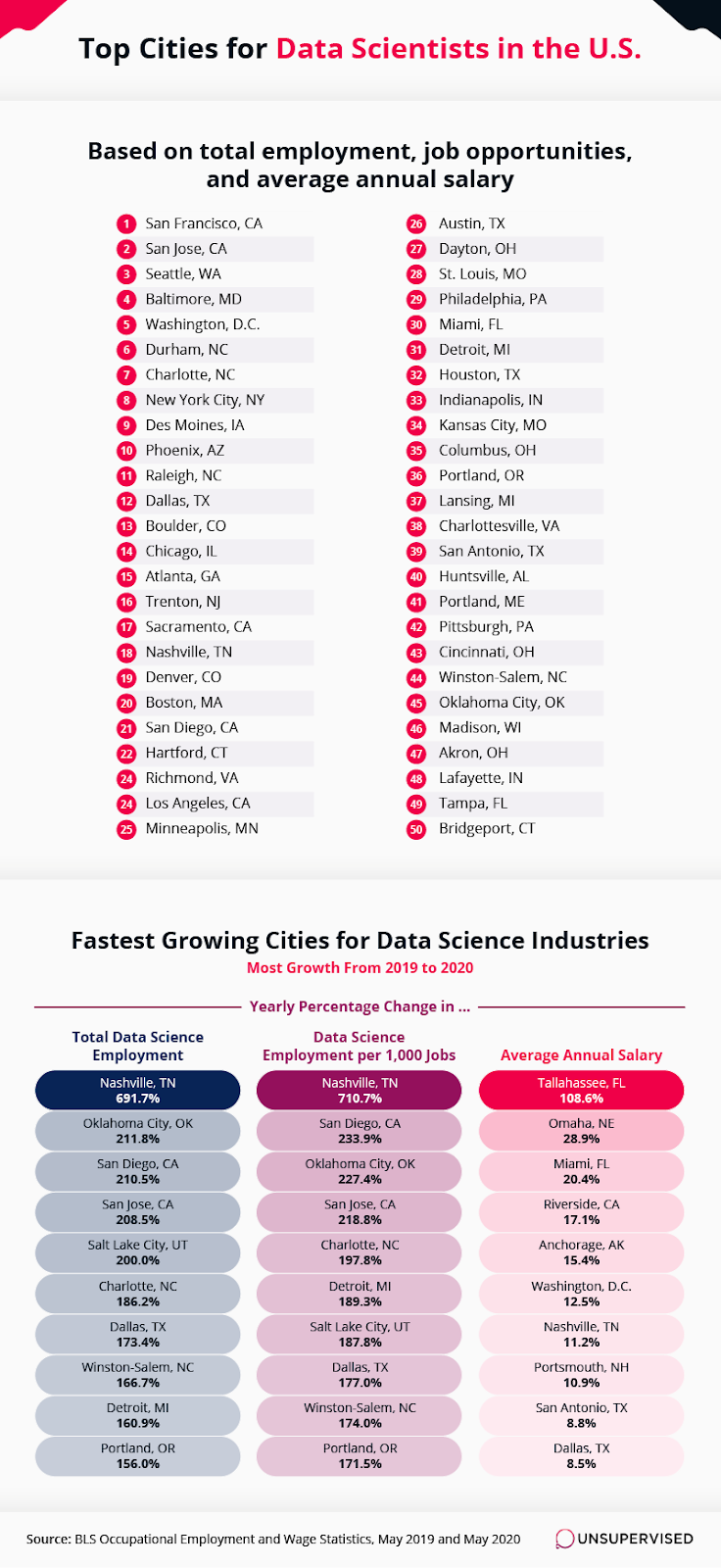
Based on our metadata, San Francisco and San Jose were the two best places to live as a data professional. These areas offered both numerous and lucrative opportunities for such employees. If California isn’t your ideal location, East Coast locations like Washington, D.C., or Charlotte, North Carolina, may work well. If you prefer to work independently, one 40-year-old male data scientist in our study explained that “I really don’t have to communicate much with people to gather and analyze data […] most scientists are independent.”
Nashville, Tennessee, became a standout city for data science when we looked at the rates of growth. Nashville saw nearly a 700% increase in data science employment, which was substantially more than any other city. They also came in first for the biggest increase in data employment per 1,000 residents, meaning the total percentage of the city that works in the field drastically changed from 2019 to 2020. Florida also offered two standout cities—Tallahassee and Miami—for the biggest increases in average data science salaries.
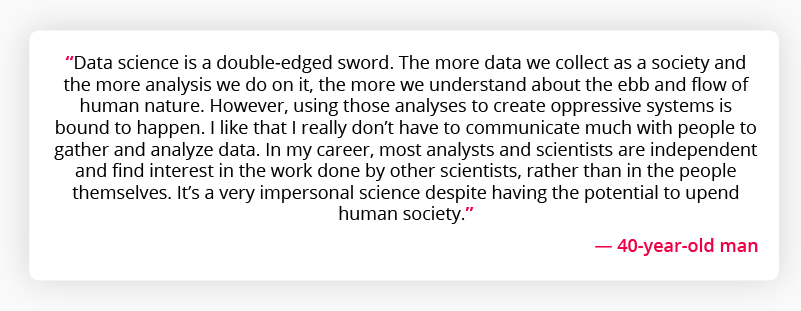
Straight from the Prospective Data Scientists Themselves
Turning away from Google Trends and BLS, we wanted to give data hopefuls throughout the country the chance to share their experiences. They shared both the most enticing and concerning aspects of the job, as well as the top tools for launching a career in the field of data.
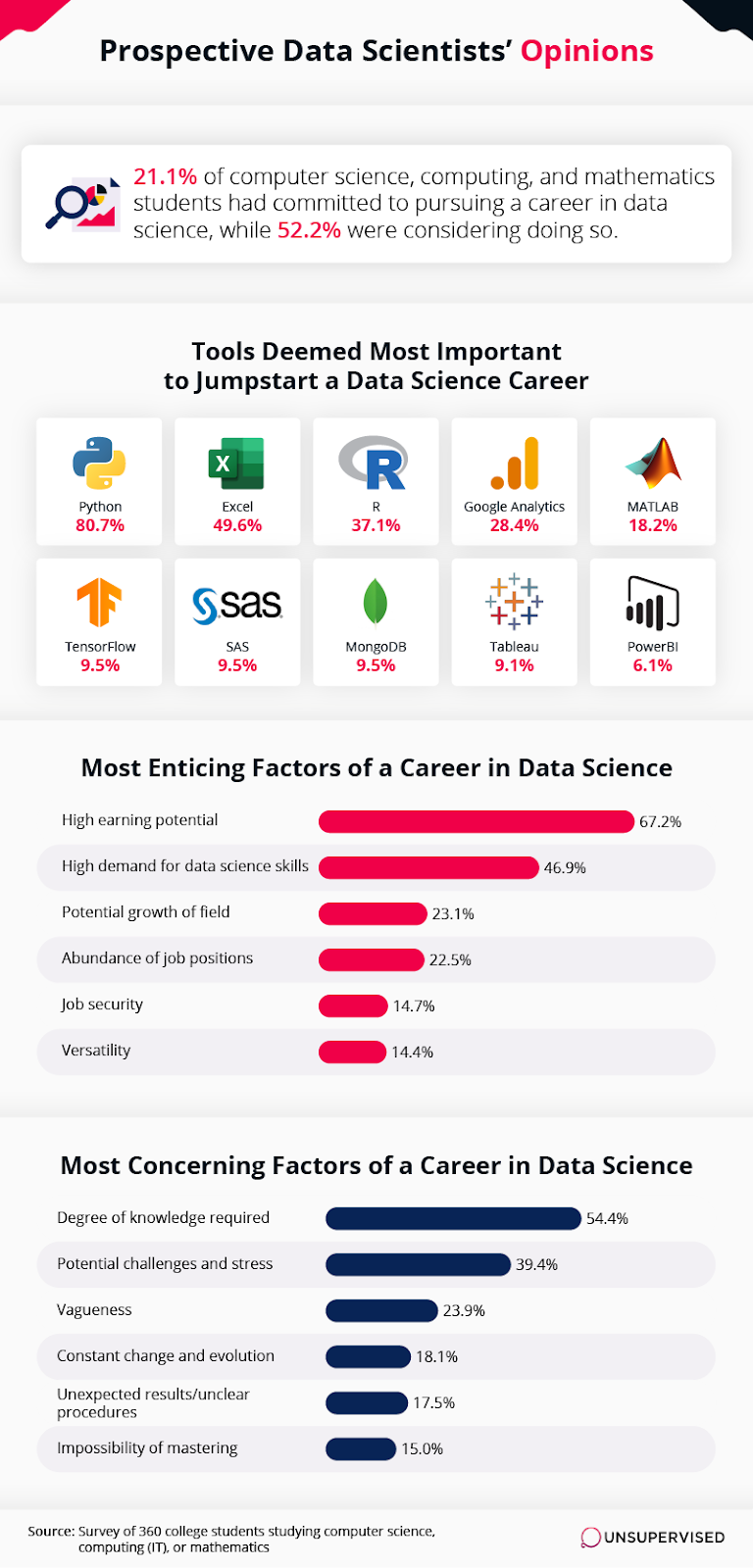
Those who study math, computer science, or computing in college are highly likely to pursue data science as a career. Twenty-one percent said they definitely will, and more than half reported considering it. This group was primarily enticed by the high earning potential (67.2%) and the high demand for their skills (46.9%). Nearly a quarter were also intrigued by the growth in the field that BLS data previously substantiated.

These data hopefuls did share some concerns, too. They noted the large amount of knowledge required for the job (54.4%) and the many challenges and stress that come with the role (39.4%). Furthermore, 15% of them already consider it fully impossible to master data science. That said, they did feel learning certain skills would give them some chance at succeeding: Learning Python was deemed essential, according to 80.7%, while half said it was important to know Excel.

Making Data Science Work for You
It’s a good time to be a data scientist. This study revealed that interest in the area has been skyrocketing, and cities all over the country are competing in various ways for talent. Massachusetts seemed a particularly common place for data education, while California seemed to be the spot for the workforce.
Ultimately, companies who need data scientists face a host of competition. They will likely need vast amounts of capital or decide to outsource for particular projects. This is where Unsupervised comes in. Unsupervised’s automated analytics platform is a cost-effective solution that can help businesses leverage their complex metrics into actionable insights. It not only enhances business user’s knowledge of their data, but does so without the need of hiring an analytics team. Want to see it for yourself? Head to Unsupervised.com today.
Methodology and Limitations
For the first part of this study, we leverage Google Trends data for the search terms “data science” and “data science jobs” from Jan 1, 2012, to Jan 1, 2022. We analyzed month-by-month relative search interest for each individually and further explored geographic trends and related queries for “data science.”
For the second part of this study, we utilized the U.S. Bureau of Labor Statistics’ Occupational Employment and Wage Statistics. Specifically, we looked at 2019 and 2020 data under the occupation “Data Scientists and Mathematical Science Operations, All Other.”
No statistical testing was performed on the Google Trends or BLS data, so the claims listed above are based on means alone. As such, this content is exploratory and is presented for informational purposes only.
For the final part of this study, we used Prolific to survey 360 college students in the U.S. studying computer science, mathematics, or computing (IT). 51.7% of respondents identified as women, 43.3% identified as men, and the remaining 5% identified as nonbinary. Additionally, the average age of these respondents was 24.1 years old with a standard deviation of 7.2 years. The quotes used throughout the study were sourced through a survey targeted toward individuals working in the data science field via Prolific.
The main limitation of this portion of the study is its reliance on self-report, which is faced with several issues, such as, but not limited to, attribution, exaggeration, recency bias, and telescoping.
Fair Use Statement
Data-backed information is always nice to have, especially when the topic is data itself. If you’d like to share this information with your audience or anyone interested in pursuing a position in the data field, you’re welcome to share the research. Just be sure your purposes are noncommercial and that you link back to this page.








